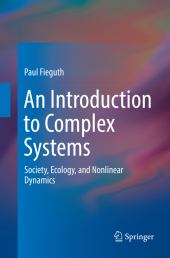 Neuerscheinungen 2018Stand: 2020-02-01 |
Schnellsuche
ISBN/Stichwort/Autor
|
Herderstraße 10
10625 Berlin
Tel.: 030 315 714 16
Fax 030 315 714 14
info@buchspektrum.de |

Paul Fieguth
An Introduction to Complex Systems
Society, Ecology, and Nonlinear Dynamics
Softcover reprint of the original 1st ed. 2017. 2018. xii, 346 S. 65 SW-Abb., 178 Farbabb., 50 Farbtabe
Verlag/Jahr: SPRINGER, BERLIN; SPRINGER INTERNATIONAL PUBLISHING 2018
ISBN: 3-319-83093-7 (3319830937)
Neue ISBN: 978-3-319-83093-3 (9783319830933)
Preis und Lieferzeit: Bitte klicken
This undergraduate text explores a variety of large-scale phenomena - global warming, ice ages, water, poverty - and uses these case studies as a motivation to explore nonlinear dynamics, power-law statistics, and complex systems. Although the detailed mathematical descriptions of these topics can be challenging, the consequences of a system being nonlinear, power-law, or complex are in fact quite accessible. This book blends a tutorial approach to the mathematical aspects of complex systems together with a complementary narrative on the global/ecological/societal implications of such systems.
Nearly all engineering undergraduate courses focus on mathematics and systems which are small scale, linear, and Gaussian. Unfortunately there is not a single large-scale ecological or social phenomenon that is scalar, linear, and Gaussian. This book offers students insights to better understand the large-scale problems facing the world and to realize that these cannot be solved by a single, narrow academic field or perspective.
Instead, the book seeks to emphasize understanding, concepts, and ideas, in a way that is mathematically rigorous, so that the concepts do not feel vague, but not so technical that the mathematics get in the way. The book is intended for undergraduate students in a technical domain such as engineering, computer science, physics, mathematics, and environmental studies.
1 Introduction.- 2 Global Warming and Climate Change.- Further Reading.- 3 Systems Theory.- 3.1 Systems & Boundaries.- 3.2 Systems & Thermodynamics.- 3.3 Systems of Systems.- Case Study 3: Nutrient Flows, Irrigation, and Desertification.- Further Reading.- Sample Problems.- 4 Dynamic Systems.- 4.1 System State.- 4.2 Randomness .- 4.3 Analysis.- 4.3.1 Correlation.- 4.3.2 Stationarity.- 4.3.3 Transformations.- Case Study 4: Water Levels of the Oceans and Great Lakes.- Further Reading.- Sample Problems.- 5 Linear Systems.- 5.1 Linearity.- 5.2 Modes.- 5.3 System Coupling.- 5.4 Dynamics.- 5.5 Non-Normal Systems.- Case Study 5: System Decoupling.- Further Reading.- Sample Problems.- 6 Nonlinear Dynamic Systems - Uncoupled.- 6.1 Simple Dynamics.- 6.2 Bifurcations.- 6.3 Hysteresis and Catastrophes.- 6.4 System Behaviour near Folds.- 6.5 Overview.- Case Study 6: Climate and Hysteresis.- Further Reading.- Sample Problems.- 7 Nonlinear Dynamic Systems - Coupled.- 7.1 Linearization.- 7.2 2D Nonlinear Systems.- 7.3 Limit Cycles and Bifurcations.- Case Study 7: Geysers, Earthquakes, and Limit Cycles.- Further Reading.- Sample Problems.- 8 Spatial Systems.- 8.1 PDEs.- 8.2 PDEs & Earth Systems.- 8.3 Discretization.- 8.4 Spatial Continuous-State Models.- 8.5 Spatial Discrete-State Models.- 8.6 Agent Models.- Case Study 8: Global circulation models.- Further Reading.- Sample Problems.- 9 Power Laws and Non-Gaussian Systems.- 9.1 The Gaussian Distribution 9.2 The Exponential Distribution .- 9.3 Heavy Tailed Distributions.- 9.4 Sources of Power Laws.- 9.5 Synthesis and Analysis of Power Laws.- Case Study 9: Power Laws in Social Systems.- Further Reading.- Sample Problems.- 10 Complex Systems.- 10.1 Spatial Nonlinear Models.- 10.2 Self-Organized Criticality.- 10.3 Emergence.- 10.4 Complex Systems of Systems.- Case Study 10: Complex Systems in Nature.- Further Reading.- Sample Problems.- 11 Observation & Inference.- 11.1 Forward Models.- 11.2 Remote Measurement.- 11.3 Resolution.-11.4 Inverse Problems.- Case Study 11A: Sensing- Synthetic Aperture Radar.- Case Study 11B: Inversion- Atmospheric Temperature.- Further Reading.- Sample Problems.- 12 Water.- 12.1 Ocean Acidification.- 12.2 Ocean Garbage.- 12.3 Groundwater.- Case Study 12: Satellite Remote Sensing of the Ocean.- Further Reading.- Sample Problems.- 13 Concluding Thoughts.- Further Reading.- Part I Appendices.- Index.


